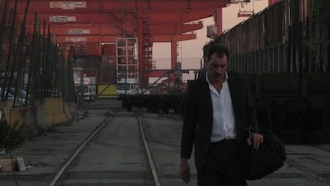
The Mouth of the Wolf 2009
Distributed by Grasshopper Film, 12 East 32nd St., 4th Floor, New York, NY 10016
Produced by Francesca Cima, Nicola Giuliano, and Dario Zonta
Directed by Pietro Marcello
Streaming, 68 mins
High School - General Adult
Cinema Studies; Communication Studies; LGBTQ+ Studies
Date Entered: 11/13/2021
Reviewed by Kimberly Poppiti, St. Joseph's College, Patchogue, NYThe Mouth of the Wolf presents the love story of Vincenzo Motta and Mary Monaco. The pair is described in the film’s promotional materials as “a Sicilian tough guy and a transexual former junkie;” but these facets of their identities are not the focus of the film. The film presents a more holistic view of their relationship, which began in prison and is set against the backdrop of Genoa, Italy. Their story unfolds largely through memory, especially in the first half to two thirds of the film, with the details established primarily through their letters to one another, which are read aloud and presented through voiceover narration. These are accompanied by music, as well as by visuals depicting an intriguing variety of scenes and imagery.
The film progresses at a relaxed pace and without a strong driving conflict. It is not until more than halfway through that Mary and Enzo appear onscreen together talking in real time about their twenty-year relationship. The scene is worth the wait and effectively ushers in the final act of the film, which unfolds largely in real-time with the pair quietly and informally reminiscing and conversing about their lives together, including their dreams of a quiet and peaceful shared old age, spent with their dogs, in a serene natural environment.
The Mouth of the Wolf is an unexpectedly beautiful film. Running just over an hour, it quietly welcomes viewers into Mary and Enzo’s world with a slow pace and non-traditional style that may prove challenging for some viewers, especially those accustomed to faster moving films, but which is, ultimately both effective and worthwhile. The film includes some verbal descriptions of violence, as well as seemingly symbolic visual images of destruction and decay. It is appropriate for audiences of high school age and older. Aspects of potential academic interest and exploration include the film’s depictions of interpersonal communication and relationship development, as well as its use of film editing and visual storytelling. The footage of contemporary and historical Genoa may also be of interest to some viewers. It is likely to be of greatest interest to those in the fields of Communication Studies and Cinema Studies, as well as to some in LGBTQ+ studies.
Awards:FIPRESCI Prize for “Best Film;” Prize of the City of Torino; Caligari Film Award and Teddy Award for Best Documentary at the 60th Berlin International Film Festival
Published and licensed under the Creative Commons Attribution 4.0 license. Anyone can use these reviews, so long as they comply with the terms of the license.